Big Sur
Lead project scientists: Kerri Frangioso and Margaret Metz
Phytophthora ramorum in the Big Sur Ecoregion:
Feedback Between a Generalist Pathogen, Hosts, and Heterogeneous Environments at Multiple Spatial and Temporal Scales

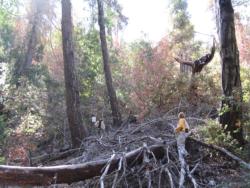
We will use these results in collaboration with various partners in Big Sur to develop a science-based management plan for the region. Land preservation efforts are well established in Big Sur, including numerous preserves, state parks and the Los Padres National Forest. However, there are still many conservation threats that cut across these areas including exotic species (plants, animals, and pathogens) and alterations of key natural processes such as a fire.
We established 280 intensive long-term monitoring plots in Big Sur in 2006 and 2007 (Figure 1). In each 500-m2 plot we have quantified disease incidence, levels of tree mortality, coarse woody debris, canopy cover and regeneration. The plots are in both mixed-evergreen and redwood forest types and span a range of SOD mortality levels. Throughout the network, plots more heavily invaded by P. ramorum have a greater number of standing dead host trees and downed logs than plots with little or no infection (Figure 2).
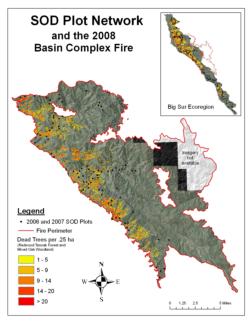
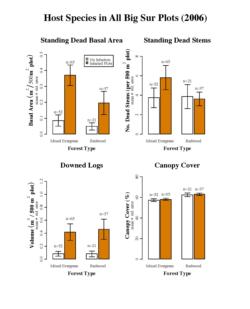
Sudden Oak Death and Fire
In 2008, the Basin Complex and Chalk Fires burned large swaths in Big Sur, including over 120 of our forest monitoring plots. The fires presented a unique opportunity to assess feedbacks between changes to forest structure caused by SOD mortality and fire dynamics across the landscape. At the local scale, we are examining the degree to which dead woody fuel loads from SOD mortality increased fire severity. At larger scales we will examine the extent to which spatial patterns of fire severity corresponded with landscape heterogeneity of SOD mortality.
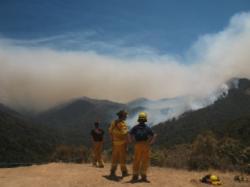
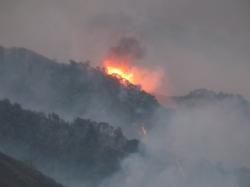
This was the first time major wildfires occurred in forests impacted by SOD, and the effect on the pathogen was unknown. We have several projects underway to understand the effects of fire on P. ramorum. These studies examine pathogen survival on both the local (plot) and the landscape (watershed) level. We are particularly interested in what biological and environmental factors were most influential in determining whether the pathogen survived the fires. The information gained from this research will provide valuable insight into what role fire, one of California’s most influential and frequent natural disturbances, plays in the epidemiology of SOD.
Adaptive Management in Big Sur
Management of millions of dead trees caused by SOD has become a key question in these fire-prone ecosystems. We have received many inquiries from land managers, policy makers and the media about how our pre-fire dataset can be used to learn from the Basin Fire. Overall, this fire is seen as an important learning opportunity for understanding and managing interactions between two pressing environmental problems – wildfires and emerging infectious diseases. Our analyses will not only help guide management decisions regarding hazards of sudden oak death, but will also be important for understanding changes to landscape heterogeneity of host availability and its effect on disease dynamics in the region.
Working together with the Los Padres National Forest and using all the information we have collected over the past few years, we are developing a forest wide strategy to help minimize the impacts and spread of SOD. We are currently looking at a variety of mitigation techniques to try to slow the spread of SOD farther south, remediate areas in the Big Sur area that have been decimated by SOD and aid with the recovery of areas severely burned with in the Basin Complex fire perimeter.
